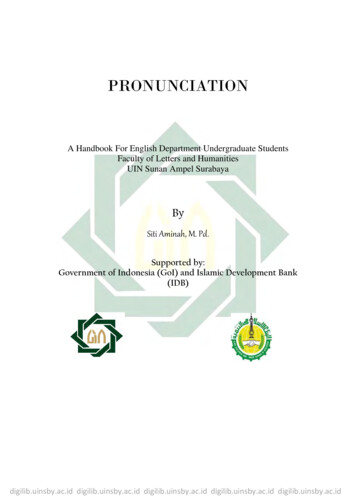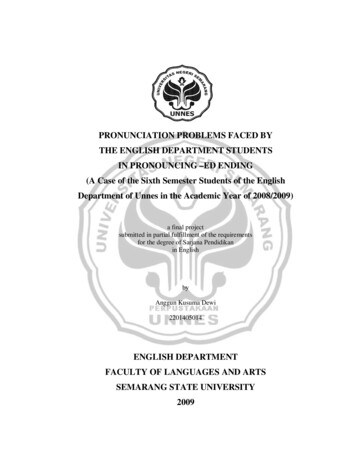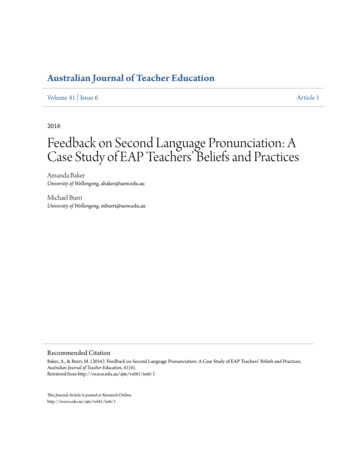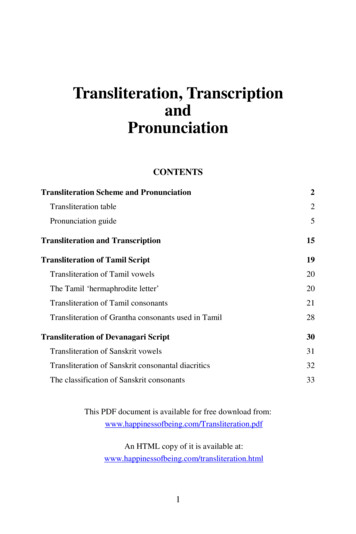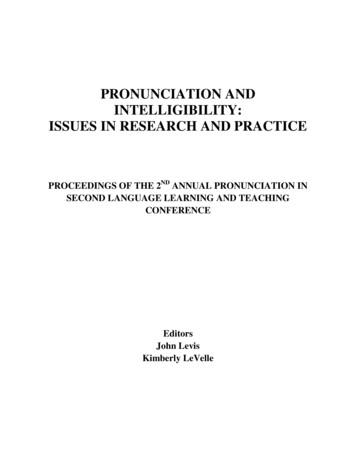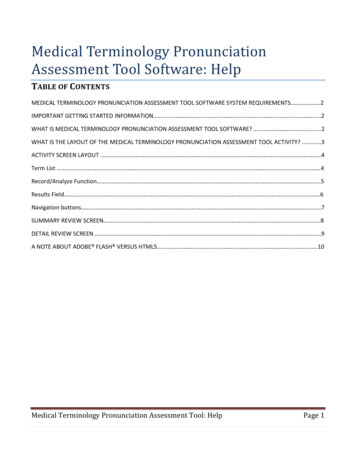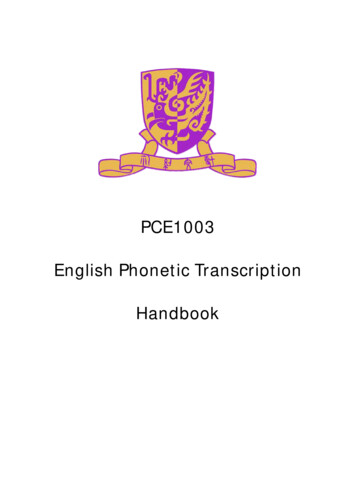
Transcription
Multicultural EducationVolume 6, Issue 5, 2020Challenges of Pronunciation to EFL Learners in Spoken EnglishMohamed AbdAlla AbdAlgane Mohammed, Somia Ali Mohamed IdrisArticle InfoArticle HistoryReceived:October 28, 2020Accepted:December 31, 2020KeywordsChallenges,Pronunciation,Segmental Features,SuprasegmentalFeatures, MotherTongue, s study is an attempt to investigate the challenges that encounter EFLlearners in proper and correct pronunciation in spoken English. Moreover,the study aims at casting the light on the significance of pronunciation inteaching as well as learning to any educational institution which adoptsEnglish as a course in the curriculum, particularly at the tertiary level. Theresearchers have followed the analytical methodology via exploiting thequestionnaire for data collection. The data presentation, analysis viaStatistical Package for Social Science (SPSS), and discussion, supportedwith tables and graphs are all included in the paper to reach appropriatefindings and recommendations that could possibly contribute to thelanguage learning problem-solving research attempts. Thus, studying thecauses of pronunciation issues to EFL learners is an extremely significantmatter emerges from the need to communicate properly with the entireworld. Correction of pronunciation mistakes made by EFL learners isalmost a daily matter that both researchers are dealing with on a regularbasis, so it has been mutually decided to investigate the roots of the problemin order to find helpful appropriate solutions.1. IntroductionTeaching pronunciation to EFL learners has been ignored and avoided immensely due to various reasons.One reason is that non-native EFL teachers are not competent enough to teach pronunciation rules tolearners. Another reason is that the vast majority of non-native teachers are not fluent enough in Englishbecause they either haven‟t studied English in an English-speaking country or not been exposed enough toan English-speaking environment. A third factor is that the teaching process of pronunciation itself is kindof hectic since it requires utilization of audio-visual devices which makes a very massive number ofteachers refrain from teaching it. A fourth factor is that teachers do not use authentic materials to teachpronunciation which hence makes it just like any other theoretical course rather than being practical andinteractive. A fifth cause is that most teachers do not adopt active learning strategies in their classes ratherthey tend to use a teacher-centered approach of teaching which makes learners bored to death in thoseclasses. Undoubtedly teaching pronunciation properly is extremely significant and surpasses theboundaries of teaching speaking skills for the sake of communication.1. Definition of PronunciationMazouzi cited in (Roach, 2002: 61): Many people think that when talking about pronunciation inlanguage learning we mean the way certain sounds are produced while speaking. But this is nothelpful to say that pronunciation is an act of producing sounds of language. Many scholars havedefined pronunciation from different perspectives. For Seidlhofer (2001: 56) pronunciation is “ theproduction and perception of the significant sounds of a particular language in order to achievemeaning in contexts of language use”. Moreover, generally the meaning of a sentence will beunderstood from the way it is pronounced (Harmer, 2001: 184). It means that when learners speak inintelligible manner they will understand and convey the desired meaning. And, for learners to beintelligible they must understand what is heard and to be understood by using simple language toolsto convey the messages.Pronunciation also plays a great role in our lives, in a way that we project our identity throughour way of speaking, and also shows our membership of particular communities (Seidlhofer, 2001:56). All of this may be the reason why teachers think of teaching pronunciation as an important anddifficult field.193
2. Overview of English PronunciationCorrect pronunciation brings success to EFL students anywhere in the world. In contrast, inadequateproficiency of English pronunciation impacts the progress of communicative aptitude that is required forbuilding up the communicative bridge between speakers and listeners.(Lin 2014) cited in (Gilakjani, 2011; Jahan, 2011): Precisely speaking, great pronunciation competencein English is able to make others understand easily; however, English pronunciation lesser to basic levelaugments the misinterpretation among conversations with others. It is not essential to speak English like anative speaker but “acceptably to be understood” (Jesry, 2005). Obviously, the favorableimpact of goodpronunciation in the process of learning English is certain and strengthened; thus, ESL students should betaught standardized ways of English articulation (Gilakjani, 2011).(Lin 2014) cited in (Charity, & Mallinson, 2011): Talking of the standardized English articulation, thefact that students‟ language dissimilaritiesinfluence how they perform in academic years of schools shouldnot be neglected. Especially, phonological discrepancy is one of language variables involving learningprocesses (Sinha, Banerjee, Sinha, & Shastri, 2009). Rather, sound patterns of learners‟ first language arelikely to affect their pronunciation in target languages (Jahan, 2011; as cited in Jesry, 2005; Zhang, 2009).Understandably, non-standardized English-speaking students are therefore afraid of being teased or feelembarrassed when they try to pronounce English accurately (Nogita,2010).It is obvious that differences in phonological system of mother languages will hinder rather thanpromote English pronunciation learning (Huang & Radant, 2009). To improve EFL students‟ Englishpronunciation, teachers thus should obtainperceptions into their pronunciation variations, which will provideteachers with ideas of designing various teaching strategies for dealing with those students‟ challenges inlearning English pronunciation. In fact, teachers are able to help all students learn standardized Englishwithout diminishing their linguistic backgrounds through knowing their language variations (Charity &Mallinson, 2011). Accordingly, verbal assessment should not be based on specific norms, but take linguisticdifferences into account and value students‟ voices. It goes without saying that knowing English languagevariation of ESL students will ultimatelyassist teachers prepare toinstruct their students, perceive thelearning challenges, and help students solve the problems (Dalle & Young, 2003). Hazen stated that “ifpeople had a better understanding of how language works, they would probably be less inclined to makenegative judgments about speakers of different dialects” (Hazen, 2001, p. 1). Undeniably, “language isintegral to both culture and identity, an understanding of language variation and language diversity is criticalto multicultural education” (Charity & Mallinson, 2011). “We can‟t teach what we don‟t know” (as cited inCharity & Mallinson, 2011). Therefore, understanding pronunciation variations facing ESL students canhelp teachers be aware of students‟ dialect diversity and challenges in learning standardizedEnglisharticulation.With a central idea on the interference of first language, the above discussions present thesignificance of being able to speak English with good articulation as well as the difficulties and problemsEFL learners encounter while acquiring English pronunciation. Unquestionably, the brief theoreticaloverview discussed above is essential in order for readers to understand the answer of the inquiry questionaddressed in this article. The next section will discuss the answer of the inquiry question through reviewingrelevant literature with regard to major pronunciation challenges encountering EFL learnerstoday.3. Significance of Teaching PronunciationMazouzi cited in(Murphy, 2003: 116): Some teachers have the idea that learners will learn topronounce English well with little or no direct instruction. Others give extensive attention to aspectsof pronunciation teaching. For Celce-Murcia (1996) pronunciation plays a crucial role in languageteaching and learning. It is non-negligible even if the necessity and importance to teach it has beendebated and changed a lot. Learning a language usually includes the aim of being able tocommunicate, and having good pronunciation is an effective factor for good communication. Whatpronunciation is responsible for is intelligibility between thespeakers. Pronunciation is taught inisolation, but this doesn‟t mean it should be regarded as separate areas of language learning. It can beregarded as contributory strands in the fabric of English (Broughton et al., 1980: 64). Whatpronunciation is responsible for is intelligibility between the speakers i.e. the aim of teachingpronunciation is not to achieve a total set of native speaker-like variations but to ensureintelligibility, by enabling the students to produce the English speech which is intelligible in the areawhere they will use it (Broughton et al., 1980: 58).Mazouzi cited in(Bailey, 2003: 50): Moreover, we should make our speech understood byothers, in order to communicate effectively in a target language. The inaccurate use of
Multicultural EducationVolume 6, Issue 5, 2020suprasegmental elements or mispronounce of phonemes will cause problems; for instance, it will beextremely difficult for speaker from another language community to understand (Kelly, 2000: 11).Nevertheless, “a learner who is aware that their pronunciation is quite good may grow in confidenceand then perform better in other aspects of speaking, such as maintaining fluency”(Watkins,2005:50).4. Segmental and Supra-segmental Features of PronunciationAs claimed by Burns. A and Claire. S (2003:4):Pronunciation can be something of a „Cinderella‟ in language teaching - to begiven low priority or even avoided. Some teachers indicated that they were unsureabout all the various features of pronunciation. Some were also unclear aboutwhether to teach it separately or as an overall part of teaching activities.Studying English as a foreign language can be a challenging effort for learners whose goal is tocommunicate effectively. One reason for the leaeners' difficulty is the sound system of English. The area ofEnglish pronunciation that is worth focusing on is of two aspects; segmental and suprasegmental which areseparate entities combine and interact to explore the role played by the speaker and the listener. They areimportant in helping language users to master the spoken language through intensive exposure to thoseaspects. Segmental aspects are related to those features of the language which are recognized as separatedsegments, such as vowels and consonants of a particular language and how they make up a syllable that canbe uttered. Suprasegmental, is the features that related to properties extending over the range of a singlesegment or the range of vowels and consonants which includes intonation patterns and stress placement,rhythm, and sounds that extend over syllables, words, and phrases. According to Brown, A (2014) cited in(Laver 1994.p152)that supra-segmental as “factors which can potentially be prolonged beyond the domain ofthe segment‟, such as pitch, rhythm, intonation, stress.”5.1. Segmental vs. Supra-segmentalAs segmental and suprasegmental phonology of English language represent fairly complex areas ofstudy; they should be explored very superficially by taking a brief look at the two phenomena of singlephoneme, word, stress and intonation. Investigating features concerning individual sounds or phonemesdetail, requires working on the segmental level since each phoneme is usually assumed to be one segment ofspeech. On the other hand, looking at larger chunks of speech, such as whole words or phrases, we deal withfeatures on the suprasegmental level. The various features of English pronunciation are illustrated in thefollowing figure:195
FEATURES OF ENGLISHPRONUNCIATIONSegmental FeaturesStressPhonemes (Soundsdifferences within alanguage)ConsonantSoundsVoicedSupra-segmental FeaturesIntonationStressIntonationLinkingVowel re (1): Features of English Pronunciation(Burns, A and Claire. S. 2003:20).5. Factors that Impact Learning English PronunciationMany studies in the field of (S/FLA) discussed the factors that impede achieving native-likepronunciation among foreign languages learners in general and among Arab learners specifically(O‟Connor,2003; Yule, 2003). Researchers and linguists have pointed some factors such as the differences of the soundsystem between the first language (LI) and the second language (L2), the inconsistency of some sounds inEnglish language, the mother tongue interference and the influence of spelling on pronunciation. These factorswere discussed separately as follows:6.1. Mother Tongue InterferenceSeveral works have been conducted on the influence of L1 in learning English language.(Wilkins1972.p.199) observes that when learning a foreign language, a personis already familiar with his/her mothertongue, and it is this which s/he tries to transfer. The transfer may prove to be acceptable because theconstruction of the two languages is similar - in that case we get „positive transfer‟ or „facilitation‟- or it mayprove baseless because the structure of the two languages isdissimilar in that case we get „negative transfer‟- orinterference.Second language learners appear to accumulate structural entities of the target language but demonstratedifficulty in organizing this knowledge into appropriate, coherent structures. When speaking the target language,learners tend to rely on their native language (L1) structures to produce a response. If the structures of the twolanguages are distinctly different, then one could expect a relatively high frequency of errors to occur in L2, thusindicating an interference of L1 on L2. Dulay et al (1982.p 25) defines interference as “the automatic transfer,due to habit, of the surface structure of the first language onto the surface of the target language.”6.2. Little Amount of Exposure to the Target LanguageAccording to language learning theories such askrashen‟s (1982), learners acquire language mainlyfrom the input they receive and they require large amounts of „comprehensible input‟ before being expected tospeak. On this basis, exposure to the (TL) would be a critical factor in pronunciation acquisition. However,Revell, P (2012 p.9) states that:Nowadays, this claim is more likely to be modified to include „proficient‟, rather than„native-speakers of the F/SL, including the non-native class teacher. It could alsoinclude „comprehensible input‟ via a variety of multimedia channels such as TV, radio,DVD or synchronous on-line chat rather than simply face-to face conversation.According to Ancker (2000:21), errors can occur for some reasons, for instance, interference from thefirst language; incomplete knowledge of the target language and the complexity of the target language itself.Kenworthy (1988:4-9) stated that: “Factors such as the native language, the age, amount of exposure, phoneticability, attitude and identity, motivation and concern for good pronunciation have great influence onpronunciation learning”.6.3. Sound System Differences between LI and L2196
197As it has been mentioned by many linguists and researchers, there is a conflict between the soundsystems of LI and L2. These studies have shown that the main problem in teaching and learning Englishpronunciation result from the differences in the sound system of English and the native language In Arabic, eachletter represents only one sound, so it‟s easy to read any word from a written text. Also, there is no sound whichis not pronounced (silent), as it happens a lot in English. When there is a difference in the sound system in theLI and L2 showed that errors are expected to be committed because the learners transfer their mother tonguesound system into the target language.In English language there are twenty-four consonants and twenty vowels; that mean there are forty-fourphonemes in English language the learner should be able to produce them while learning English. “Learners ofdifferent language backgrounds will of course face some difficulties to pronounce them because of theirlanguage background” (O‟Connor, 2003.p 22). In Arabic language the whole number of the sounds is less thanthe one in English language, so the total sounds of Arabic language are twenty-eight letters each of themrepresents only one sound. So, there are only twenty-eight sounds in Arabic language.6.4. Inconsistency of English VowelsOne of the important problems faced by the students of English is that, each English vowel has morethan one pronunciation. So, this causes many difficulties to the learners and leads them to a mispronunciation.Instead of using the exact quality and quantity of a special sound, the learner erroneously changes either thequality or the quantity of the sound; so, in a certain word the learner tends to use the variant sounds e.g. son/sʌn/, come /kʌm/, among /əmʌŋ/, blood /blʌd/; in all these words /o/ and /oo/ stand for the same sound of /ʌ /,but most of the learners, unless they have a mastery of the pronunciation of such vowels, they mispronouncethose words.The learner, who doesn‟t have sufficient knowledge of different pronunciations of the vowels above,meets some difficulty, since s/he uses different variants of their pronunciations.(Kharma and Hajjaj 2011.p.14) summarized this as: The spelling of Arabic is overwhelmingly regular.In contrast, the spelling of English is seemingly very irregular. Moreover, to the learner, written English is notalways a reliable guide to pronunciation, and they are often misled by the graphic representation of sounds.(Swan and Smith‟s 2002: 196)have stated that “English has 22 vowels and diphthongs to 24 consonants”, while“Arabic has only six vowels and no diphthongs to 32 consonants.”6.5. Influence of Spelling on PronunciationEven when students are equipped with both abilities to hear sounds in sequence and grasp Englishrhythm, there remains the fact that English spelling is so complicated that it is hard even for native speakers tolearn. Speakers of many other languages in which the sounds and the letters are more closely connected have amuch easier time learning to spell in their L1 than native speakers of English have learning to spell in theirs.Both phonetics and phonology deal with sounds. As claimed by (Forel, C. A., & Puskás, G. 2005.p.3) that:English spelling and English pronunciation are two very different things. Forinstance, English has not 5 or 6 but 20 different vowels, even if these vowels are allwritten by different combinations of 6 different letters, "a, e, i, o, u, y". e.g. please,[pli:z]. Thus, the word please consists of three consonants, [p, l, z], and one vowel,[i:].(O‟Connor, 2003) claimed that some words which are ordinarily spelt in the same way are different intheir pronunciation. Also, there are some words spelt in a different way, but have the same sound e.g., rain, rein,reign, all of them are pronounced /rein/. The learner, who still doesn‟t have the mastery of pronunciation of suchwords, pronounces each of them by looking at its spelling, and he is expected to mispronounce them. So, if thelearner doesn‟t know such relationship between sound and spelling, s/he mispronounces words by just lookingat their spellings e.g., before the n the k is silent; knee, know, knot, knight a student who didn‟t learn theirpronunciation correctly, pronounces them with the /k/ sound. Any time the student meets such words he will beconfused to pronounce them correctly he just guesses the pronunciation by looking at the spelling of the wordunless he has previous background.6.6. Lacking of MotivationMotivation has been broadly accepted by both teachers and researchers as one of the vital factors thataffect the rate and success of second/foreign language (L2) learning. Motivation provides the principalincentiveto initiate learning the L2 and later the driving force to sustain the long and often tedious learning process;indeed, all the other factors involved in L2 acquisition presuppose motivation to some extent.According to Zoltan Dornyei (2009, 217): “Without sufficient motivation, even individuals with themost remarkable abilities cannot accomplish long-term goals, and neither are appropriate curricula and goodteaching enough on their own to ensure student achievement.”On the other hand, high motivation can make upfor considerable deficiencies both in one's language aptitude and learning conditions.Although 'motivation' is a term frequently used in both educational and research contexts, it is rathersurprising how little agreement there is in the literature with regard to the exact meaning of this concept? As hasclaimed by Zoltan Dornyei (2009, 217): “Researchers seem to agree that motivation is responsible for197
198determining human behavior by energizing it and giving it direction, but the great variety of accounts putforward in the literature of how this happens may surprise even the seasoned researcher.”6. Study QuestionsThis study is an attempt to investigate the challenges that encounter EFL learners in proper and correctpronunciation in spoken English. Moreover, the study aims at casting the light on the significance ofpronunciation in teaching as well as learning to any educational institution which adopts English as a course inthe curriculum, particularly at the tertiary level.In order to achieve the above aims, the paper is designed to seek answer to the following questions:1. What are the most common pronunciation challenges that EFL learners encounter in English language whenthey speak? However, sub-question has been stated as follow:What are the plans and techniques that considered the most effective in encouraging learners to improve theirpronunciation?Moreover, this paper is trying to investigate the roots of the problem in order to find helpful appropriatesolutions.8. Methodology and Study PopulationResearchers have adopted the analytical research methodology by means of using SPSS program for dataanalysis of a questionnaire that has been distributed to a random sample group of 100 tertiary levelstudents.The age of the students (males and females) ranges between (18-22) years old. They study English astheir specialization and as a foreign language in a formal setting. They have a similar language history orbackground in the sense that they all had spent 7 years learning English before joining college. None ofthem had been to an English- speaking country. All of them are native speakers of Arabic Language.1.English language learners encounter pronunciation problems due to lack of practice.Since 70 % of the responders strongly agreed to the statement, 20 % agreed, and 10 % were neutral, this provesthat “English language learners encounter pronunciation problems due to lack of practice” is valid.STRONGLY DIS AGREE0%DIS AGREE0%NEUTRAL10%AGREE20%STRONGLY AGREE70%Chart (1)Chart (1) elucidates that lack of pronunciation practice causes problems.2.English language learners confuse between similar sounds in pronunciation such as /p/ and /b/, /f/ and/v/, etc.Since 66 % of the participants strongly agreed to the statement, 24 % agreed, and 10 % were neutral, thisproves that “English language learners confuse between similar sounds in pronunciation such as /p/ and /b/,/f/ and /v/, etc.” is valid.STRONGLY DIS AGREE0%DIS AGREE0%NEUTRAL10%AGREE24%STRONGLY AGREE66%Chart (2)Chart (2) shows that learners confuse between similar sounds.3. Silent letters cause a major problem in pronunciation.In this statement 58 % of the responders strongly agreed, 34 % agreed, and 8 % were neutral, which proves that“Silent letters cause a major problem in pronunciation” is valid.
199STRONGLY DIS AGREE0%DIS AGREE0%NEUTRAL8%AGREE34%STRONGLY AGREE58%Chart (3)Chart (3) clarifies that silent letters cause a major problem in pronunciation.4.Diagraphs are considered problematic to English learners in pronunciation.According to the responses in statement: “Diagraphs are considered problematic to English learners inpronunciation” 30 % of the participants strongly agreed, 20 % agreed, 14 % neutral, 16 % disagreed, and 20 %strongly disagreed, which proves that the statement is acceptable.STRONGLY DIS AGREE20%DIS AGREE16%NEUTRAL14%AGREE20%STRONGLY AGREE30%Chart (4)Chart (4) displays that diagraphs are considered problematic to English learners in pronunciation.5. Some English sounds do not exist in learners' languagephonological system.According to the responses in relation to the statement: “Some English sounds do not exist in learners' languagephonological system.” 36 % of the participants strongly agreed, 42 % agreed, 6 % disagreed, and 16 % were notsure, which proves that the statement is valid.STRONGLY DIS AGREE0%DIS AGREE6%NEUTRAL16%AGREE42%STRONGLY AGREE36%Chart (5)Chart (5) demonstrates that some English sounds do not exist in learners' language phonological systemcause pronunciation poblems.6. Stress position in isolated words is difficult for student to apply.Chart (6) reflects that all respondents 100% decided that they failed in placing stress on the correct syllable.Hence, word stress placement is one of the main pronunciation difficulties.STRONGLY DIS AGREE0%DIS AGREE0%NEUTRAL0%AGREE22%STRONGLY AGREE78%Chart (6)Chart (6) shows thatstress position in isolated words is difficult for student to apply.7. Syllabication is the most problematic area for learners.199
200As shown in chart (7), 98% of the subjects, strongly agreed or agreed that they faced difficulties with wordssyllable division. This was an indication that learners were aware of their weaknesses regarding pronunciationelements. Only 2% were not sure.STRONGLY DIS AGREE0%DIS AGREE0%NEUTRAL2%AGREE22%STRONGLY AGREE76%Chart (7)Chart (7) demonstrates thatsyllabication is the most problematic area for learners.8. Vowel length is difficult for learners to distinct.Chart (8) provides an answer that 100% of the study subjects had difficulty in the vowel length contrast such as/æ/ and /ɑ:/. This means that vowel length differentiation is considered as a major problematic area.STRONGLY DIS AGREE0%DIS AGREE0%NEUTRAL0%AGREE20%STRONGLY AGREE80%Chart (8)Chart (8) clarifies thatvowel length is difficult for learners to distinct.9. Learners have challenges with consonantal clusters.Chart (9) shows the responses on consonantal clusters difficulties such as “spring” and “next”, 90% of learnersfaced problem with consonant clusters. The respondents who strongly disagreed or disagreed were representedby the low percentage 10%. What is learnt from this distribution is that the pronunciation of consonants clusterseemed to be a major problematic area.STRONGLY DIS AGREE0%DIS AGREE2%NEUTRAL8%AGREE26%STRONGLY AGREE64%Chart (9)Chart (9) shows thatlearners have challenges with consonantal clusters.10. Intonation rules are difficult for learners to use properly.According to chart (10), the results revealed that applying intonation rules is considered as obstacles facestudents. 90% of the participants strongly agreed or agreed that the; %6 disagreed. The remaining was not sure.Hence intonation is one of the common difficulties of EFL pronunciation.
201STRONG DIS AGREE0%DIS AGREE6%NEUTRAL4%AGREE20%STRONG AGREE70%Chart (10)Chart (10) explains thatintonation rules are difficult for learners to use properly.9. Discussion:This paper contributes to the identification of specific areas of challenges which hampercommunication through the mispronunciation of spoken language. In this part, the pronunciation difficulties,which students might face when they speak English, were presented and discussed. The results presented aboverevealed that, the EFL learners seemed to have English pronunciation challenges assumed by theresearchers.The majority of learners enunciated that their major challenges are related to the lack ofpronunciation practice; however, there are other main difficulties considered as obstacles faced learners suchas:incapability to differentiate between English sounds pairs such as [p] and [b];[f] and [v]; the disappearance ofsome English sounds in learners' language phonological system andthe difficulties with words syllable division.It seemed to appear that word stress position was the most problematic area. According to the resultsdemonstrated above, the most problematic area for students seemed to be the word stress placement. Moreover,learners stated that it is difficult for them to apply the rules of intonation,meanwhile in English; intonation playsa very important role in changing the meaning of a sentence.Moreover, the results revealed that there were somefactors might contribute to these challenges.The researchers supported the idea of suggesting repair strategies for the sake of helping students toovercome these difficulties adding that students should listen to proper pronunciation from their teachers, as thefirst source of input and should be provided with opportunities to work with minimal pair practice activities.10. FindingsThe study has reached several different findings based on analysis of the collected data:1. Vowels-recognition difficulties in which students were not able to differentiate between vowels of the TargetLanguage (TL) in terms of length. While virtually all vowels may cause problems, the most confusing ones were:[ɑ:] and [æ] in “part and pat”, students tend to pronounce the two words with the same vowel quality,2. Mispronunciation of consonants that do not exist in Arabic language such as [p] and [v] in “park and very”were pronounced as / bærk/and/ferɪ/ instead of/ pɑ:k/ and /verɪ/ .3. Consonant
helpful to say that pronunciation is an act of producing sounds of language. Many scholars have defined pronunciation from different perspectives. For Seidlhofer (2001: 56) pronunciation is " the production and perception of the significant sounds of a particular language in order to achieve meaning in contexts of language use".
